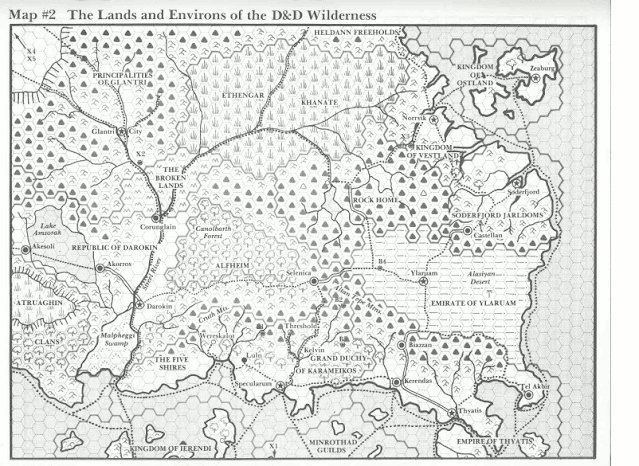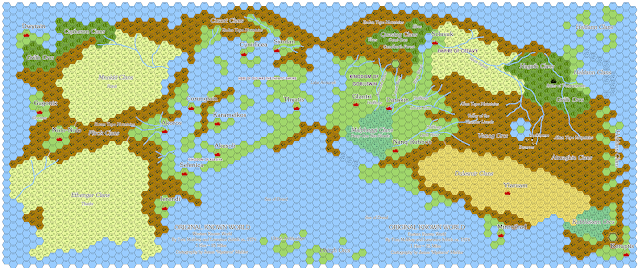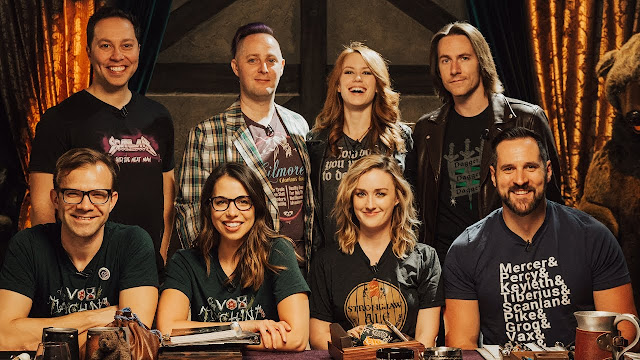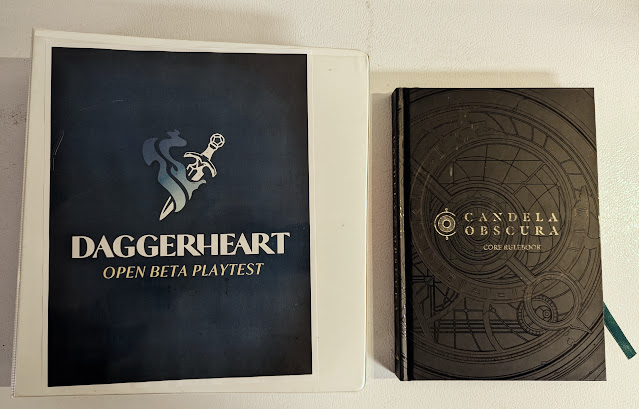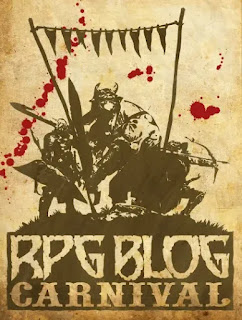These are the questions I will try to answer on this special Halloween edition of In Search Of...
In Search Of...TSR's R.I.P.
So, what do we know about this game? Very little to be honest.
- It is modern-day horror.
- Slated to be published in 1991
- Trademark was applied for in 1990.
- Written by Scott Herring [sic], Jim Ward, and Paul A. Linberg [sic]
- At least one accessory, Lost Souls, was planned and another, a set of cards, were mentioned.
And that is really about it. From the TSRArchive, we learned that it was going to be a boxed set with 32, 64, and 96-page rule books. Dice, cards and fold out maps. I am speculating here that the books were some combination of a fast-play Basic set of rules, complete rules, and possibly an adventure. But that is only a guess. There could have been Game Master's books and a creature book. IF we are to follow the clues from Top Secret, it would have been a Player's book (96), a Game Master's book (64), and maybe an equipment book or world guide.
This is only a guess. Afterall they misspelled two of the three authors on the cover.
Scott Haring is known for his contributions to GURPS, Dragonlance, Mystara, and the Forgotten Realms. His contributions to Top Secret S.I., Agent 13 and Ghostbusters might interest us more here today though.
Jim Ward was the creator of Metamorphosis Alpha; he also wrote a lot of material for D&D and then would later move on to various publishers, including Troll Lord Games. In particular to this conversation Ward designed the "Tainted Lands" horror setting for Castles & Crusades. James died earlier this year on March 18, 2024.
Paul Arden Lidberg was one of the founders of Crunchy Frog Enterprises/Team Frog Studios. He also worked on many games and was part of the TSR West group with Flint Dille for a brief time. He went on to create the games Critter Commandos and Duel. Paul died on June 13, 2022.
Now we do know there is a history of TSR padding their product schedules. David "Zeb" Cook recently stated at Gamehole Con that he would come up with names of products and other writers developers would have to figure out what that meant. This seems slightly more than that, but not by much. You can't even trust the art. TSR catalogs often had concept or placeholder art in place of a product. That is not an uncommon thing really. The "blue" Rules Cyclopedia cover is a good example.
In the early 1990s we know TSR was feeling the heat from the new kid on the block, Vampire the Masquerade. I have been talking about the effects of that game and White Wolf all month long in my Ravenloft retrospective. 1987's "Lost Boys" and "Near Dark" showed that vampire movies were still popular and there were certainly rumors about the upcoming Francis Ford Coppola Bram Stoker's Dracula scheduled for 1992. Even Chill saw new 2nd Edition from long time thorn in TSR's side, Mayfair Games. The time was ripe for a supernatural game.
We do know from many sources, notably Steve Winter, that next to nothing was produced for the game, beyond this cover mock-up. There are no files siting on a 5.25" floppy somewhere and no dot-matrix print out of chapter 1 or anything like that. I do think we have seen everything about this game, save for maybe some TSR inter-office notes or emails that likely no longer exist.
There are two product codes that appeared in the TSR catalogs for this.
- TSR07404: R.I.P. Horror RPG
- TSR07405: R.I.P. Horror Card Game
- TSR07406: Lost Souls
Here is the text featured, along with the art from the cover.
"Nobody's safe. The undead disregard today's best high-tech security and surveillance systems. These demons attack helpless victims as they sleep - their electronic fences and computers buzz through the night. This horror and much, much more fill the R.I.P. role-playing game. This all-new game awaits horror fans with three rules booklets, full-color cards, dice and maps that spin a tale in modern-day terror."
This is our best clue to what the game was going to be about. But it is not the only one.
The R.I.P. Comics
Our best guesses at the tone and tenor of the game come from the R.I.P. Comics produced by TSR a couple of years before. Two four-issue series were released. And because I care about you, my faithful readers, I scored 3/4ths of them.
What can we say about the comics?
- There were two series of four for a total of 8 comics.
- Described as "Comics Modules."
- Published around the same time TSR had a comics deal with DC.
- Each had some game related content, sometimes Top Secret/S.I. related, sometimes standalone.
- Flint Dille, brother of Lorraine Williams, was the creative director.
Flint Dille also wrote the Agent 13, Top Secret/S.I. tie-in media, Agent 13: The Midnight Avenger.
Now I am being honest here, the comics are not very good. But that is fine, because I am not interested in that. Why I bought these was for the last section of the comics, the game materials. The comic themselves feel a bit like Tales From the Crypt.
In Issue #1 (I will just number these 1 to 8 for ease), has notes for adapting the Top Secret/S.I. part 1 by Scott Haring. This first section details the type of horror game you might want to run. There is nothing particular to the TS/SI rules here, just campaign modes.
Issue #2 shares the same art as the proposed TSR07406: Lost Souls book. This includes the Zombie Hunt game, with rules in the center and a play board on the inside covers, and tokens. Part 2 of our TS/SI aka Role-Play in Peace, section covers some new advantages and disadvantages. Mostly for dealing with the supernatural. They promise more are coming, just write to TSR West.
Issue #3 adds to the Zombie Hunt game with Zombie Rampage. For TS/SI we get some new skills and some Powers as described in the Agent 13 book. This game takes the Chill 2nd edition approach and has the Powers limited to "the bad guys." You know it would not stay that way for long. Powers here are treated like Skills.
Issue #4 gives us some monsters. Or at least I would like to say it does. The trouble is the text is small and printed on a color background that is almost impossible to read. I tried a lot of different filters and skill could barely read it. We get Vampires, Werewolves, Frankenstein's Monster and a Mad Slasher.
The Zombie Nation game, a continuation of the zombie games from Issue #1 is written by Paul A. Lidberg.
Issue #5 (or 1 of the second series) features more Role-Play in Peace with some Monster powers by Scott Haring AND a R.I.P. collector card game by Paul Lidberg, which could be the same as TSR07405: R.I.P. Horror Card Game listed above.
Issue #7 (I do not own Issues #6 or #8) includes a solitaire game called The Crypt by Paul Lidberg and a page of a new power (Cause Madness) for Top Secret/S.I.
Now, this certainly begs the question. Was the only material written for the R.I.P. RPG sitting before me right now?
The R.I.P. RPG
It would be folly to try and guess what the completed R.I.P. RPG would have been like, AND would we have called "Rip" or "Are Eye Pea?" But that doesn't mean I can't make some guesses. Especially given some of the Vampire:TM "catch-up" TSR was doing at the time with Ravenloft. For the record, "Are Eye Pea."
Obviously, the biggest, and maybe the most error-prone guess, is that the system used would have been some version of TSR's Top Secret/S.I. RPG. I mean there is no reason to assume it would have been this, comics examples aside, especially since TSR had a history of using a different system for each and every game. BUT maybe with the new Top Secret/S.I. TSR saw a way into modern games. The comics certainly give at least some lip service to this.
My other "evidence" is the product codes. R.I.P. had the 74xx line and Top Secret/S.I. covered the 76xx numbers. Not that this is solid evidence save for the fact they were all "in production" at the same time.
I think a safer guess is that Vampires would have played a bigger role in this than what little evidence we have. I have stated in the my reviews of Van Richten's Guide to Vampires and Children of the Night Vampires that TSR was well aware of the growing popularity of Vampires and Vampire RPGs. While we know the the production teams were often siloed and unaware of what the others were doing, who knows what would have become of Ravenloft if R.I.P. had been a hit? Would Ravenloft still have been produced? Would we have seen Gothic Earth for R.I.P. instead?
What can I speculate about this game?
Well, there are certainly tie-ins to the Agent 13 sourcebook. In fact, a 1990s update to that is not just a safe bet but likely the only safe bet.
The Agent 13 novels are throwbacks to the pulps of the 30s, save without the charm of being from the 30s. I mean, they were throwbacks in the late 80s, but I am not sure they would have fared much better in the 90s. So, the new R.I.P., even if it builds on the mythos of that brand, would need to be thoughtfully updated. The Lemuria origins of the Brotherhood would still be fine. Even the evil takeover of the Brotherhood. Given the 90s, I expect to see more about the Freemasons, the Templars, and plenty of other secret groups. Agent 13 portrayed heroes and villains in terms of black and white. R.I.P. would likely do something similar. While other horror games of this time (Chill 2nd Ed, Vampire, Kult, SLA, CoC) were embracing shades of gray, they were all fairly dark. No one was "pure good," but I do see TSR, especially TSR of the early 90s, trying to push a "PCs are good guys" narrative.
For monsters, I am sure there will be vampires, werewolves, Frankenstein's monster(s), zombies, and very likely succubi. I would also expect to see all sorts of "high tech" monsters too, like brains kept alive via advanced machinery, "Borg"-like monsters, and maybe even monsters caused by modern problems like global warming and pollution. Would the monsters be well known to normal humans? I can see different campaign modes that allow this or keep them secret. I think our best evidence of this is to look toward Ravenloft for AD&D 2nd Ed.
One thing that is very easy to guess is that I am sure there will be more skills regarding Occult sciences and powers that "agents" can take. These would be limited, but more skills than the ones seen in the Agent 13 book. Again, I think the model here would be what Chill or SLA Industries were doing in the 90s.
I would also expect to see a re-print and expansion of all the different types of campaign settings mentioned in the comic. From humor to slasher flicks, to monster hunters to cosmic horror. It is the 1990s, but the X-Files are still a couple of years off (1993), so I am not expecting Governmental and Alien conspiracies just yet. I would expect a group of some sort the PCs could work with. Like ORION from Top Secret/S.I. or even SAVE from Chill.
Given what we saw in Top Secret/S.I., Agent 13, and later in AD&D 2nd Ed Ravenloft, I fully suspect that there was going to be some secretive shadowy organization bent on World DominationTM, that is, if they didn't already control everything, whom the characters will have to fight the agents of. Whether this takes the shape of The Brotherhood or something more akin to the Dark Powers is difficult to guess. It is likely would be skewed more to the Brotherhood side.
In truth, we will never know. With 2/3rds of the writing team gone, the company gone, and the persistent suspicion that nothing was ever really produced for it there is not enough to go on.
But I think I will see if the idea has any legs all the same. Check back tomorrow.
Links
- R.I.P. Modern Day Horror, TSR Archive
- Entry at RPGGeek.com
- RPGNet: Can anyone tell me about TSR's R.I.P. game?
- Grognardia: Two RPGs That Never Were
- R.I.P. Comics
- R.I.P. Comics
- Review of the comics
- TSR Was Planning to Launch a Comic Book Company in 1992!
- Crapbox of Cthulhu: Halloween POST-A-DAY, October 19, 2016
- Horror RPGs Historical review: Age of Ravens
- Authors
RPG Blog Carnival
This post is my last entry for my October RPG Blog Carnival: Horror and Fantasy.. I hoped you enjoyed. I'll post a wrap-up for it tomorrow as well.
HAPPY HALLOWEEN!
























